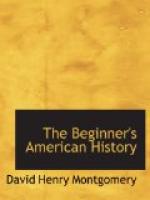In the spring of 1607 the emigrants reached Chesapeake[1] Bay, and sailed up a river which they named the James in honor of King James of England; when they landed they named the settlement Jamestown for the same reason. Here they built a log fort, and placed three or four small cannon on its walls. Most of the men who settled Jamestown came hoping to find mines of gold in Virginia, or else a way through to the Pacific Ocean and to the Indies, which they thought could not be very far away. But Captain Smith wanted to help his countrymen to make homes here for themselves and their children.
[Illustration: Map showing Jamestown.]
[Footnote 1: Chesapeake (Ches’a-peek).]
39. Smith’s trial and what came of it; how the settlers lived; the first English church; sickness; attempted desertion.—As soon as Captain Smith landed, he demanded to be tried by a jury[2] of twelve men. The trial took place. It was the first English court and the first English jury that ever sat in America. The captain proved his innocence and was set free. His chief accuser was condemned to pay him a large sum of money for damages. Smith generously gave this money to help the settlement.
As the weather was warm, the emigrants did not begin building log cabins at once, but slept on the ground, sheltered by boughs of trees. For a church they had an old tent, in which they met on Sunday. They were all members of the Church of England, or the Episcopal Church, and that tent was the first place of worship that we know of which was opened by Englishmen in America.
When the hot weather came, many fell sick. Soon the whole settlement was like a hospital. Sometimes three or four would die in one night. Captain Smith, though not well himself, did everything he could for those who needed his help.
When the sickness was over, some of the settlers were so discontented that they determined to seize the only vessel there was at Jamestown and go back to England. Captain Smith turned the cannon of the fort against them. The deserters saw that if they tried to leave the harbor he would knock their vessel to pieces, so they came back. One of the leaders of these men was tried and shot; the other was sent to England in disgrace.
[Footnote 2: Jury: a number of men, generally twelve, selected according to law to try a case in a court of law; in criminal cases they declare the person accused to be either guilty or not guilty.]
40. The Indians of Virginia.—When the Indians of America first met the white men, they were very friendly to them; but this did not last long, because often the whites treated the Indians very badly; in fact, the Spaniards made slaves of them and whipped many of them to death. But these were the Indians of the south; some of the northern tribes were terribly fierce and a match for the Spaniards in cruelty.




